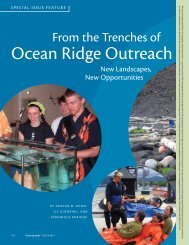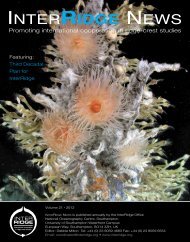Full version, lower resolution, 3.25MB - InterRidge
Full version, lower resolution, 3.25MB - InterRidge
Full version, lower resolution, 3.25MB - InterRidge
Create successful ePaper yourself
Turn your PDF publications into a flip-book with our unique Google optimized e-Paper software.
International Research<br />
extinct hydrothermal chimneys.<br />
The host rocks of the deposits at Ashadze 1, 2, and 3<br />
are serpentinized peridotites with interspersed gabbroic<br />
bodies which are very common in the rift valley slopes in<br />
this segment of the MAR. Two sampling dives were carried<br />
out to study the composition of fluids, the animal<br />
communities, the bacteria, and the minerals associated<br />
with the hydrothermal vents. Another original characteristic<br />
is the unexpected observation of gas bubbles in the<br />
smokers of Ashadze 1. These bubbles are the evidence of<br />
ongoing subsurface boiling processes, and indicate that<br />
the temperature at shallow depth must be over 400°C.<br />
On the Ashadze 2 site a large group of smokers occurs,<br />
in a crater-shaped depression, about 25 m in diameter at<br />
the bottom of the graben structure. This constructional<br />
structure may indicate the sometimes-explosive nature<br />
of the hydrothermal fluid emissions.<br />
Logatchev. These sites are on the eastern wall of the rift<br />
valley. Logatchev 1 and 2 sites, 5 km apart, are located<br />
8 km and 12 km off-axis. We only mapped Logatchev<br />
1 with the ROV (Fig. 3) . It comprises many vents in<br />
a NW-trending elongated area about 400 m-long (e.g.,<br />
see article by Borowski et al., this volume). High <strong>resolution</strong><br />
mapping at 20-m altitude (550 x 750 m) reveals the<br />
circular shape of the main sulfide mounds, as well as<br />
complex arrays of scarps and fissures, oriented predominantly<br />
E-W and NE-SW (Ondreas et al., 2007). Numerous<br />
lens-shaped slump features are also revealed near the vents.<br />
One important goal was the exploration for new sites in the<br />
Logatchev area. During a 13-km exploration dive (Fig. 3), we<br />
unsuccessfully looked for the Logatchev 3 site at the top of<br />
the rift valley wall. However, the Logatchev 2 site, thought to<br />
be inactive, was localized and found to be active and located<br />
on serpentinized mantle rocks. The venting fluids (temperature<br />
320°C) are unusual for their low salinity, which is the first observation<br />
of the production of a condensed vapor phase for a<br />
mantle-based hydrothermal system. In addition, its position 12<br />
km off-axis, moves from 8 (Logatchev 1) to 12 km the possibility<br />
to have off-axis black smokers along the MAR. At the end of<br />
the exploration, a new low temperature (dominantly birnessite)<br />
inactive hydrothermal field (Logatchev 5) was discovered at the<br />
summit of the Logatchev ridge, located 1 km east of Logatchev<br />
1. The second objective at Logatchev 1 was black smoker fluid<br />
sampling for time-series studies and additional biological observations<br />
and sampling.<br />
Krasnov. This site was observed for the first time by ROV during<br />
the Serpentine dives. Submersible observations as well as a<br />
high-<strong>resolution</strong> map established at an altitude of 50 m, revealed<br />
several spectacular characteristics of this deposit. First, it is<br />
probably the largest accumulation of massive sulfides known<br />
Figure 2: (upper) High <strong>resolution</strong> mapping operations done during<br />
dive 310-01 at Ashadze 1 and 2.<br />
Figure 3: (<strong>lower</strong>) Exploration and high <strong>resolution</strong> map at Logatchev<br />
1 done during dive 316-07.<br />
to date. The second remarkable characteristic is the collapse of<br />
half of the sulfide mound towards the axial valley. This phenomenon<br />
creates a large deposit of sulfide talus in the west and<br />
a spectacular 100-m high semi-circular section of the mound,<br />
showing the heart of the massive sulfide mound at the east.<br />
The site was found to be inactive. The samples collected by the<br />
ROV and by dredging show a dominance of iron sulfides, and<br />
the scarcity of minerals rich in zinc and copper. The samples<br />
also revealed the brecciated character of the mineralization<br />
and the almost-complete replacement of a basaltic breccia by a<br />
mixture of pyrite and silica. This type of mineralization is very<br />
similar to the samples collected by drilling in the heart of the<br />
TAG sulfide mound at 26°N on the MAR.<br />
Hydrothermal precipitates<br />
Basaltic hosted deposits are dominated by pyrite and silica at<br />
Krasnov (Fe: 39%, Si: 11%, Cu: 2.2%, Zn: 0.14%) and by<br />
sphalerite and pyrite at Ashadze 4 (Fe: 24%, Si: 1.5%, Cu:<br />
0.15%, Zn: 32%). Ultramafic deposits are characterized by<br />
high copper concentration dominated by chalcopyrite and isocubanite.<br />
Ashadze 1 (Fe: 33%, Si: 1.3%, Cu: 14%, Zn: 14%)<br />
<strong>InterRidge</strong> News 17 Vol. 17, 2008
















